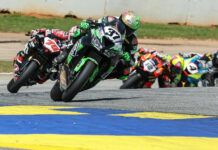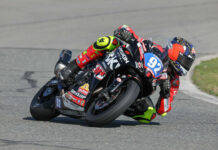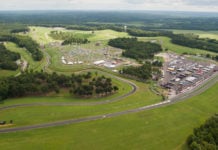Copyright 2002, Roadracing World Publishing, Inc.
By Glenn LeSanto
Suzuki GSX-R1000

It’s only two years since the bike was launched and yet already Suzuki engineers are giving the bike an extensive revamp. Suzuki press materials say the engineers have updated the GSX-R with ‘more power, less weight, and all-new frame, and an exciting, aggressive aerodynamic look.’
The stacked headlight front end might not strike everyone as ‘exciting and aggressive.’ It’s got more than a hint of the Hayabusa about that new front end and for some that’s a bad thing.

Suzuki engineers haven’t done a lot of work to the motor, they didn’t really need to as these things are already missiles. New ventilation holes between adjacent cylinders help to equalize pressure underneath the pistons. The system allows air that’s been pushed down by the descending pistons to escape to the adjacent cylinder where the piston is rising and pressure is dropping. Suzuki’s changes make the route that this air has to travel to do its equalisation job shorter. Keeping the pressure level like this in the engine stops all manner of bad stuff going on down in the engine’s basement. The system, says Suzuki, reduces crankcase pressure and the associated mechanical power loss. Up top, to simplify design and save 50gms, external oil lines to the cam chain tensioner have been replaced by internal oil passageways.
The styling changes aren’t just about looks, not least according to the Suzuki men. They reckon that the changes allowed them to move the inlets for the ram-air system nearer to the middle and front of the bike. This is the point of highest air pressure and the ideal place to gather oxygen-rich air to stuff into the 10.2 litre airbox. Slots have been added at the base of the velocity stacks inside the airbox reduce intake pulses, this smoothes mid-range power delivery.
The all-new frame is also part of the styling changes; it’s painted black, which the press men say ‘goes along with its unique profile.’ The fairing nose, according to Suzuki, is shaped like that to maximise wind protection both on and off the track. Other slight ergonomic changes include narrowing the fuel tank near the saddle to air rider comfort, and coincidentally, making it easier for a racer to tuck in.
Suzuki engineers have been busy with the electronics at the heart of the GSX-R. They’ve upgraded the ECM (Electronic Control Module), it’s gone from 16 bits to 32 bits, which means it can process information much faster. The little box also holds onto more data while it’s working, going up to 256k in ROM (read only memory) from 96k on the old model. Basically all this thinking power helps the ECM keep things clean. It can work stuff out faster and make quicker and more accurate adjustments to the injection and ignition to ensure fuel gets burned efficiently and completely. The electronic brain speed gain also leads to better throttle response because the ECM can work harder and faster to respond to rider input and mix up the air and fuel exactly right.
An upgraded engine speed signal generator has 22 poles instead of the old model’s 8. This is designed to keep the ECM supplied with more information on the precise engine speed. The ECM has 8 injector control maps on board, two for each cylinder. The system’s light load maps calculate fuel injection volume using engine rpm and intake pressure, while the system’s heavy-load maps use engine rpm and throttle opening. The ECM calculates ignition timing using throttle position and engine rpm. In keeping with the obsession for weight loss in this class, the ECM is 5mm shorter and 15grams lighter than the 2002 model’s ECM.
Interestingly, the old four-throttle-body set up has been set aside in favor of two double-barrel bodies. Bore size and internal shape remains the same, tapering from 50mm at the airbox side to 42mm at the intake manifold. The new one-for-two assembly saves weight and is simpler. The single injector per cylinder system is the latest version of the SDTV (Suzuki Dual Throttle Valve) system previously fitted. This dual butterfly valve system ensures the bike responds more like a carburetted bike at low speed, and yet has all the performance and efficiency enhancements of injection.
The rider controls the primary throttle valve with the twist grip. The timing of the secondary throttle butterfly valve is controlled by the ECM. It senses what opening the secondary butterfly valve needs depending on data it’s receiving about the position of the first butterfly valve and engine speed. It then progressively opens or closes the secondary valve to optimize intake velocity.
Suzuki’s answer to the EXUP valve, they call it SET (Suzuki Exhaust Timing) is also handled by the ECM. The butterfly valve located in the pipe between the collector and the silencer is worked by the ECM via a servo motor. The SET valve matches exhaust system back pressure to engine speed, throttle position and gear selection. The valve closes to increase pressure, torque and throttle response at lower rpm. Then the valve progressively opens to reduce back pressure and improve mid range response and high rpm power.
Suzuki claim SET gives a 7% boost in torque and a 17% reduction in emissions at around 3000 rpm. SET also reduces exhaust noise at running speeds typically found in city traffic.
Suzuki engineers have gone to town with the exhaust system throwing out the stainless steel and building the entire exhaust system from titanium. Out with the stainless steel went 600 more grams of weight. But yet the end can uses a titanium core pipe with an aluminum-alloy outside cover, saving 300gms over all titanium construction.
The end can is bigger this year, 100mm longer and 10mm larger in outside diameter. Suzuki claims the resultant increase in internal volume improves flow and aids power production without adding noise. Fresh air is squirted into the exhaust to light up those unburned hydrocarbons by Suzuki’s PAIR (Pulsed secondary AIR) system. Europe models carry a catalyst in the silencer can and meet Euro 2 emission regulations easily.
Suzuki engineers have cleaned up the chassis, making it, yes you’ve guessed it – lighter and simpler. The rear subframe is all-new but frame geometry is unchanged. Cast steering head and swingarm pivot-plate sections are still used, but the main frame spar on each side is now made of an extrusion with internal reinforcing ribs. These divide the spars into three internal compartments, this Suzuki engineers say has helped them precisely adjust the frames rigidity based on data received from their GSV-R MotoGP bike. They’ve also made the tailsection mounts on the swingarm pivot-plates less likely to break in a minor racetrack tumble.
A business-like swingarm uses extruded main arms welded between the extruded pivot tube and link front sections and the axle mount ends. The black-painted item is braced with a substantial cross-member.
Suzuki designers opted for radial style front brake mounting on the latest GSX-R1000. Radial-mount callipers attach with the mounting bolts positioned aligned to the center line of the calliper, instead of using transverse mountings. They are more rigid, with less flex in the mounts and in the calliper body itself. This means harder braking and more control. It looks good, too! Suzuki engineers have gained so much braking power they’ve actually shed 20mm off the front disc size to aid response at turn-in. 300mm (11.8inch) discs replace the old 320mm (12.6inch) rotors. This says goodbye to another 300grams. There’s no change at the rear brake.
Front suspension is inverted forks with 43mm tubes coated with Diamond Like Carbon (DLC) and are, of course, fully adjustable. The piggyback reservoir rear shock is also adjustable for everything.
The new instrument cluster has LED turn signal, high beam, neutral and low fuel indicator lights into the face of an analogue tachometer. Speed readout is by LCD display, as are odometer, trip, clock and water temperature. Suzuki designers have clustered essential information closer together on the display, meaning the rider’s eye needs less movement to gain more information.
An LED taillight is fitted, this is more compact, and simpler than a conventional bulb and is also brighter. New turn signals are also simpler and more compact.
Specifications
Engine
Type: Liquid-cooled 4-stroke, 4 cylinder, inline, DOHC, 4 valves per cylinder.
Bore X Stroke: 73 x 59
Capacity: 988cc
Compression ratio: 12.0:1
Carburetion: Fuel injection, 2 x dual 42mm throttle bodies
Oil capacity: 3.6L
Lubrication system: Wet sump
Ignition: Digital electronic
Starter: Electric
Transmission: 6 speed
Primary drive ratio: 1.553
Final drive ratio: 2.470
Frame type: Aluminum-alloy beam
Rake/Trail: 24 degrees / 96mm (3.8inches)
Suspension
Front: Inverted Telescopic forks, 43mm tubes
Rear: Swingarm, progressive linkage, oil damped single shock,
All fully adjustable for rebound and compression damping and spring preload
Brakes
Front: Radial mount 4-piston callipers, 300mm dual discs
Rear: 2-piston calliper, 220mm disc
Wheels
Front: 3.50×17 inches, cast aluminium-alloy
Rear: 6.00×17 inches, cast aluminium-alloy
Tyres
Front: 120/70ZR17
Rear: 190/50ZR17
Fuel tank: 18L
Overall length: 2,045mm (80.5inches)
Overall width: 712mm (28.1inches)
Overall height: 1,135mm (44.7inches)
Wheelbase: 1410mm (55.5inches)
Ground clearance: 130mm (5.1inches)
Seat height: 830mm (32.3inches)
Dry weight: 168kg (370lb)
Colours:
Pearl Suzuki Deep Blue / Glass Splash White;
Metallic Sonic Silver;
Candy Burning Copper / Solid Black
Suzuki SV1000

SV1000
Suzuki 996cc V-Twin engine is back again, this time in two incarnations, a naked version, the SV1000, and a half-faired number, the SV1000S.
The pair are a logical addition to the stable, adding to the longer established but smaller capacity SV650 range. To make the match more precise Suzuki engineers also revamped the SV650 and SV650S to bring them inline with the styling of the new SV1000 range.
The SV1000S version has an aggressive half-fairing up front that has more than a shade of Fazer about it, especially around the dual fox-eye headlights. Meanwhile the clocks have got a Raptoresque triangular surround. Overall the bike looks good, smart and aggressive. The standard version is very much like the standard SV650. Up front there’s a big round headlight and no sissy plastic except for the micro-sidepanels and seat cowl.
The SV has an all-new new chassis, and this goes across the SV range, as the 650s have also got a new set of metalwork. The big 996cc V-Twin is a good engine but it needs a hefty bit of scaffolding to hold it in check. Suzuki opted for an aluminum-alloy truss frame with four major components: A cast steering head section, with a matching swingarm pivot aft. These are joined together by two truss sections, one on each side. This combination isn’t revolutionary but Suzuki engineers say their application of it is.

SV650S
Each of those main frame sections is made as a single precision die casting using a new high-vacuum-mold process that eliminates bubbles, air pockets and porosity in large castings. Suzuki enginers say doing this instead of making the large sections from lots of small pieces enhances consistency. The chassis produces a wheelbase of 1435mm (56.5 inches) and seat height of 810mm, (31.9 inches).
Rear wheel suspension is by a single shock with a piggyback reservoir. The swingarm is made from cast pivot sections and extruded arms attaching to the shock by a progressive link. Spring preload, rebound and compression damping are adjustable. Rear wheel travel is 130mm (5.12 inches).
Up front there’s a pair of conventional right-way-up forks with plenty-thick 46mm stanchions. The forks are adjustable for preload, rebound damping and compression damping and deliver 120mm, (4.72 inches) of travel. Both models use a 3.50 x 17-inch front wheel and a 5.50 x 17-inch rear wheel. Front stopping power is provided by a pair of 310mm, (12.2-inch) rotors being bitten by a pair of four-piston front calipers. Rear braking is by a single dual-piston rear caliper and a 220mm, (8.7inch) rear disc. To save weight and no doubt cost, Suzuki engineers dispensed with the torque arm and hold the rear caliper in place with a swingarm mounted stopper.
All this is wrapped around Suzuki’s big-bore short-stroke 90 degree V-Twin mill. The 98mm x 66mm engine produce plenty of torque and power and, especially in the naked version, this’ll be a physical bike to ride hard, even though it only tips the scales at 185kgs dry. The four valve per cylinder engine uses chrome-moly-steel connecting rods, plain main bearings and a short, rigid crankshaft. Forged Aluminum-alloy pistons have cut-away sides and short wrist-pins and an L-shaped upper compression sealing ring to improve sealing. The bores are coated with Suzuki’s race-proven nickel-phosphorus-silicon-carbide coating, known as SCEM (Suzuki Composite Electrochemical Material).
This mechanical beauty breathes in through a pair of 36mm intake valves and back out using 33mm exhaust valves. Included valve angle has been kept at a narrow 29 degrees, using an angle of 14 degrees for the intake and 15 for the exhaust. Compression ratio is 11.3:1. The pair of double overhead cams are spun at half engine speed, with the reduction being obtained by looping the chain around a small crankshaft sprocket and over large cam sprockets. A short chain runs between an intermediate shaft gear-driven off the crankshaft and a small idler positioned underneath and between the cams. Because the speed reduction is handled at the intermediate shaft, the cam drive gears can be smaller in diameter helping to reduce overall cylinder height. The exhaust valve is positioned 10mm lower than the intake to further cut down overall engine size.
Like on many modern sports motorcycles, the Suzuki’s gearbox shafts are stacked vertically, and not one in front of another. This shortens the length of the gearbox, meaning smaller engine dimensions but also allowing chassis engineers more scope for working out the overall geometry. The transmission features a back-torque-limiter of the type used in racing. The system relieves pressure on the clutch plates during downshifting to avoid rear wheel hopping and correspondingly increases the pressure on the 149mm diameter plates during acceleration. This allowed Suzuki enginers to use lighter clutch springs adding to rider comfort and shaving off engine weight.
The clutch cover also houses a large-volume crankcase breather system that separates oil from pressurised air that’s on its way back to the engine via the airbox.
The motor breathes in without the aid of ram-air into a large 9-liter airbox housed under the front of the petrol tank. Fuel and air are mixed up and pushed into the engine using the latest version of Suzuki’s Dual Throttle Valve system. Well tried on the GSX-R models, this gives a smoother throttle response, especially in the on-off throttle scenario where many other injected bikes perform poorly.
Everything is controlled by a 32 bit Electronic Control Module, or ECM. The rider controls the primary throttle valve with the twist grip. The timing of the secondary throttle butterfly valve is controlled by the ECM. It senses what opening the secondary butterfly valve needs depending on data it’s receiving about the position of the first butterfly valve and engine speed. It then progressively opens or closes the secondary valve to optimize intake velocity. Measured at the intake manifold, the throttle body is 52mm in diameter.
The ECM also looks after the injector and ignition timing. It receives data about engine rpm, throttle position and, in European models, the oxygen content of the exhaust. All European models are fitted with an exhaust catalyst and meet Euro 2 emission standards. To further reduce emissions, the SV has Suzuki Pulsed-secondary AIR injection (PAIR) system. This injects clean air from the airbox into the exhaust ports to ignite unburned hydrocarbons.
Both models have standard equipment such under-seat storage large enough for a U-Lock, luggage tie down points, LCD speedo and digital clock and LED rear lights.
Specification
Engine
Type: Liquid-cooled 4-stroke, 2 cylinder, 90 degree V-Twin, DOHC, 4 valves per cylinder.
Bore X Stroke: 98 x 66
Capacity: 996cc
Compression ratio: 11.3:1
Carburetion: Fuel injection, two x 52mm throttle bodies
Oil capacity: 3.3L
Lubrication system: Wet sump
Ignition: Digital electronic
Starter: Electric
Transmission: 6 speed
Primary drive ratio: 1.838
Final drive ratio: 2.352
Frame type: Aluminum-alloy beam
Rake/Trail: 24.5 degrees / 99mm (3.9inches)
Suspension
Front: RWU Telescopic, 46mm tubes
Rear: Swingarm, progressive linkage, single shock,
All fully adjustable for rebound and compression damping and spring preload
Brakes
Front: 4-piston calipers, 310mm dual discs
Rear: 2-piston caliper, 220mm disc
Wheels
Front: 3.50×17 inches, cast aluminum-alloy
Rear: 5.50×17 inches, cast aluminum-alloy
Tyres
Front: 120/70ZR17
Rear: 180/55ZR17
Fuel tank: 17L
Overall length: 2130mm (83.9 inches)
Overall width: SV1000S: 730mm (28.7 inches) SV1000: 790mm (31.1 inches)
Overall height: SV1000S: 1,170mm (46.1 inches) SV1000: 1,080mm (42.5 inches)
Wheelbase: 1435mm (56.5 inches)
Ground clearance: 140mm (5.5 inches)
Seat height: 810mm (31.9 inches)
Dry weight: SV1000S: 189kg (417lb) SV1000 185kg (408lb)
Colors:
SV1000S:
Metallic Sonic Silver, Candy Grand Blue or Candy Burning Copper
SV1000:
Metallic Sonic Silver, Candy Grand Blue or Pearl Novelty Black






